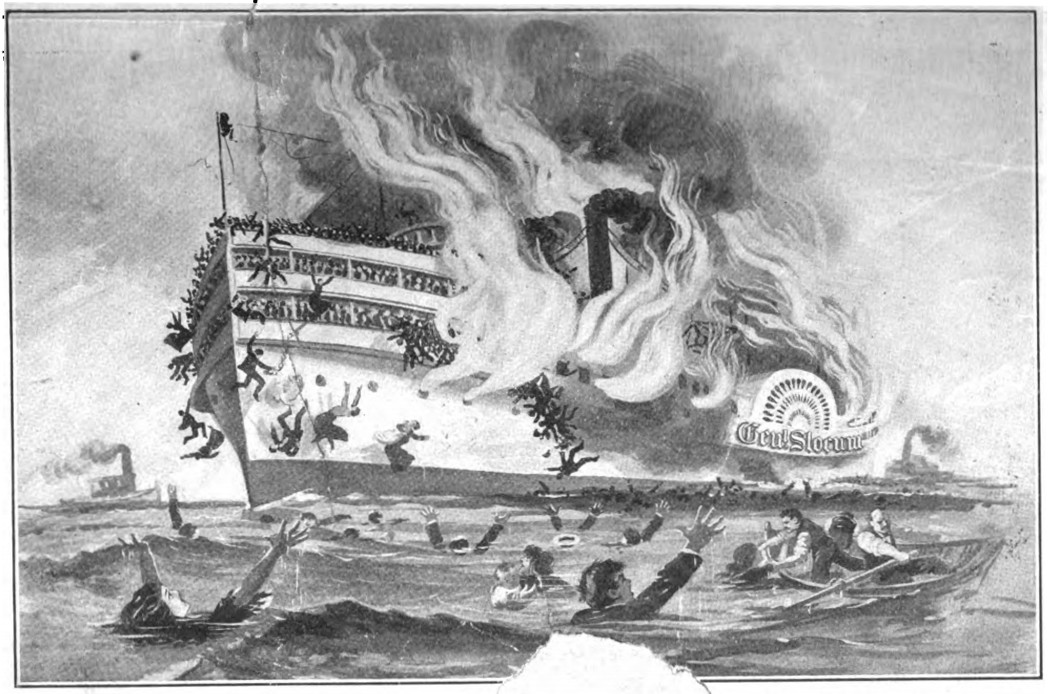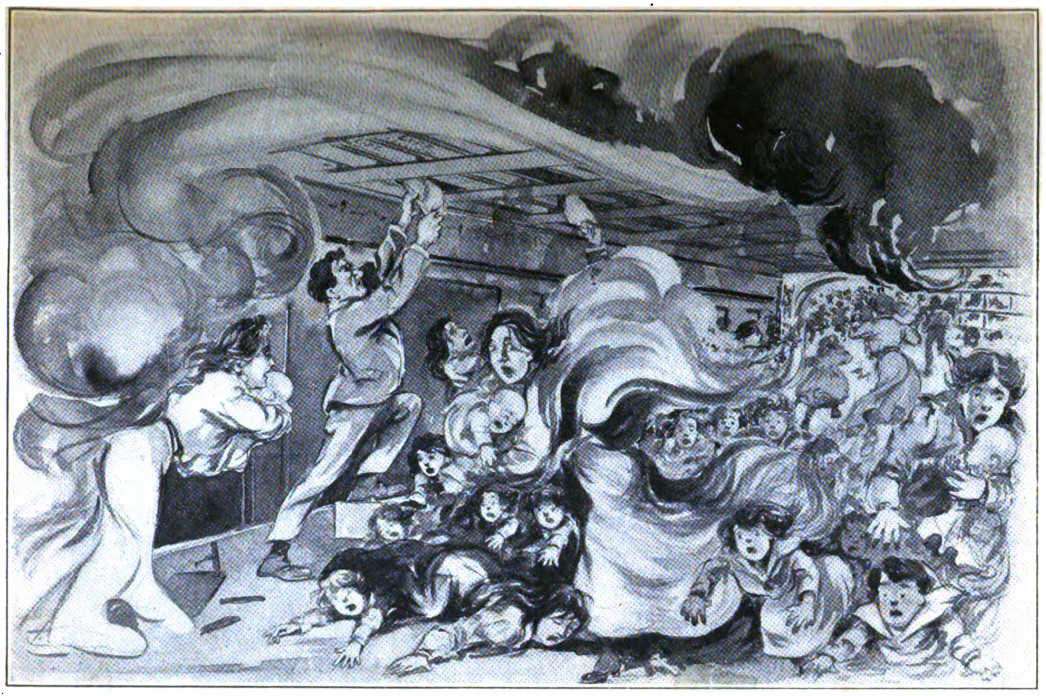250-The General Slocum
Futility Closet
Greg Ross
4.8 • 748 Ratings
🗓️ 27 May 2019
⏱️ 34 minutes
🧾️ Download transcript
Summary

In 1904 a Manhattan church outing descended into horror when a passenger steamboat caught fire on the East River. More than a thousand people struggled to survive as the captain raced to reach land. In this week's episode of the Futility Closet podcast we'll describe the burning of the General Slocum, the worst maritime disaster in the history of New York City.
We'll also chase some marathon cheaters and puzzle over a confusing speeding ticket.
Intro:
At his death in 1838, the governor of Bombay was transported into innumerable pussycats.
Sources for our feature on the General Slocum:
Edward T. O'Donnell, Ship Ablaze: The Tragedy of the Steamboat General Slocum, 2003.
Henry Davenport Northrop, New York's Awful Steamboat Horror, 1904.
"In re Knickerbocker Steamboat Co. (District Court, S.D. New York, April 7, 1905)," in The Federal Reporter: Cases Argued and Determined in the Circuit and District Courts of the United States, Volume 136, 1905.
Gilbert King, "A Spectacle of Horror -- The Burning of the General Slocum," Smithsonian.com, Feb. 21, 2012.
Frances A. Scully, "Tragic Last Voyage of the General Slocum," Sea Classics 37:2 (February 2004), 14-17, 66-67.
Valerie Wingfield, "The General Slocum Disaster of June 15, 1904," New York Public Library, June 13, 2011.
Ted Houghtaling, "Witness to Tragedy: The Sinking of the General Slocum," New York Historical Society Museum & Library, Feb. 24, 2016.
Valerie Bauman, "Anniversary of 1904 General Slocum Steamboat Disaster Marked," Newsday, June 10, 2017.
"100 Years After the General Slocum Fire, Smoke on the Water," Newsday, June 15, 2004, A42.
Glenn Collins, "A 100-Year-Old Horror, Through 9/11 Eyes," New York Times, June 8, 2004.
John E. Thomas, "Echoes of a Church Picnic," Newsday, May 23, 2004, G06.
Douglas Martin, "Last Survivor of General Slocum Steamboat Disaster Was 100," Montreal Gazette, Feb. 6, 2004, E7.
Douglas Martin, "Adella Wotherspoon, Last Survivor of General Slocum Disaster, Is Dead at 100," New York Times, Feb. 4, 2004.
Jay Maeder, "Built Like a Bonfire General Slocum, 1904," New York Daily News, March 12, 1998, 31.
Eric Pace, "Years After Ship Fire Captain's Role Debated," New York Times, June 11, 1984.
"Survivors Remember the General Slocum," New York Times, June 11, 1979.
David C. Berliner, "Fateful Day on Which 1,030 Died Is Recalled," New York Times, June 9, 1974.
"General Slocum Disaster Is Commemorated Here," New York Times, June 10, 1963.
"Mrs. Anna Kindley Dies; Nurse Took Part in General Slocum Rescue in 1904," New York Times, Nov. 7, 1958.
"Van Schaick Pardoned; Captain of the Ill-Fated Slocum Is Restored to Full Citizenship," New York Times, Dec. 20, 1912.
"The General Slocum Gone; Ill-Fated Steamer, Converted Into a Barge, Sinks Off Atlantic City," New York Times, Dec. 6, 1911.
"Last of the General Slocum; Hull of the Steamer of Disaster Sinks as a Brick Barge," New York Times, March 7, 1909.
"Captain of Slocum Surrenders to Law," Deseret News, Feb. 27, 1908.
"Full Extent of the Law: Sentence of Captain of the Gen. Slocum," [Washington, D.C.] Evening Star, January 28, 1906, 2.
"Thousands Sob as Baby Unveil Slocum Statue," New York Times, June 16, 1905.
"Indictment for Slocum Captain," Minneapolis Journal, July 29, 1904, 1.
"Slocum Memorial," New York Tribune, July 8, 1904, 2.
"Slocum's Owners and Crew Held," Clinton [Iowa] Morning Age, June 30, 1904.
"Grand Opera House Benefit," New York Tribune, June 25, 1904, 3.
"No More Needed for Relief," New York Tribune, June 24, 1904, 7.
"Over Six Hundred Perish," Muskogee [Okla.] Cimeter, June 23, 1904, 2.
"Official Inquiry Into Burning of the Steamer General Slocum," [Washington, D.C.] Evening Star, June 22, 1904, 6.
"Seven Hundred Lives Lost," Stark County [Ohio] Democrat, June 17, 1904, 1.
"Hundreds Perished by Fire and Water," [Newberry, S.C.] Herald and News, June 17, 1904, 1.
"504 Bodies Found," Boston Evening Transcript, June 16, 1904.
"The 'General Slocum,'" New York Times, June 16, 1904.
"The General Slocum an Unlucky Craft," New York Times, June 16, 1904.
"More Than Six Hundred Women and Children Die on Flaming Vessel or Leap Overboard to Drown," San Francisco Call, June 16, 1904, 1.
"Horror in East River," New York Tribune, June 16, 1904, 1.
"Horror Claims Over a Thousand," Washington Times, June 16, 1904, 1.
"An Appalling Catastrophe Women and Children Perish," [Walla Walla, Wash.] Evening Statesman, June 15, 1904, 1.
"City and Suburban News," New York Times, June 26, 1891.

Listener mail:
Stephanie Gosk, Rich McHugh, and Tracy Connor, "Marathon Investigator Derek Murphy Reveals How He Catches Cheaters," NBC News, Jan. 22, 2017.
Nik DeCosta-Klipa, "For a Marathon Cheater, the Biggest Obstacle Isn't in Boston," Boston Globe, April 3, 2019.
Mark Wilding, "Meet the Marathon Cheats," Guardian, Oct. 28, 2018.
Jen A. Miller, "Cheating to Make the Boston Marathon? You Can’t Run From This Detective," New York Times, April 11, 2019.
Wikipedia, "Rosie Ruiz" (accessed May 19, 2019).
This week's lateral thinking puzzle was contributed by listener Lex Beckley.
You can listen using the player above, download this episode directly, or subscribe on Google Podcasts, on Apple Podcasts, or via the RSS feed at https://futilitycloset.libsyn.com/rss.
Please consider becoming a patron of Futility Closet -- you can choose the amount you want to pledge, and we've set up some rewards to help thank you for your support. You can also make a one-time donation on the Support Us page of the Futility Closet website.
Many thanks to Doug Ross for the music in this episode.
If you have any questions or comments you can reach us at [email protected]. Thanks for listening!
Transcript
Click on a timestamp to play from that location
| 0:00.0 | Welcome to the Futility Closet podcast, forgotten stories from the pages of history. |
| 0:14.5 | Visit us online to sample more than 10,000 quirky curiosities from a migrating ice block to a feline reincarnation. This is episode 250. I'm Greg |
| 0:24.6 | Ross. And I'm Sharon Ross. In 1904, a Manhattan church outing descended into horror when a passenger |
| 0:31.8 | steamboat caught fire on the East River. More than a thousand people struggled to survive as the |
| 0:37.2 | captain race to reach |
| 0:38.4 | land. In today's show, we'll describe the burning of the general Slocum, the worst maritime |
| 0:43.9 | disaster in the history of New York City. We'll also chase some marathon cheaters and puzzle over a |
| 0:50.9 | confusing speeding ticket. |
| 1:05.0 | June 15th, 1904 was a special day for the members of St. Mark's Lutheran Church on Manhattan's Lower East Side. They would be taking a steamboat excursion to Long Island to mark |
| 1:09.4 | the completion of the Sunday school year. This was their 17th annual trip, a highlight of the season for the parishioners, |
| 1:15.3 | most of whom were working class German immigrants and their children. To carry them, they'd |
| 1:19.5 | hired the General Slocum, a passenger steamboat that could be chartered for excursions around the |
| 1:23.5 | city. No steamboat in New York could match the Slocum's beauty, opulence, speed, size, and maneuverability. |
| 1:30.2 | Launched in 1891, she was 264 feet long, with three large open decks and paddle wheels 31 feet |
| 1:36.6 | across. The captain, William von Schaich, 67 years old, lived on the boat. He was the only captain |
| 1:42.2 | the Slocum had ever had. On this beautiful June day, |
| 1:45.5 | about 1,300 passengers, mostly women and children, boarded the ship to cruise up the East |
| 1:50.1 | River and then across Long Island Sound to Eaton's neck for a picnic. The ship got underway at 9.30 a.m. |
| 1:56.0 | As it was passing East 90th Street, something happened in the forward storage cabin below the main deck, |
| 2:01.9 | known as the lamp room. This held kerosene, brass polish, paint, charcoal, and barrels of hay |
| 2:07.2 | that were being used to transport glasses for the picnic. Possibly a lamp overturned when the ship |
| 2:12.2 | rolled, perhaps an overhead wire shed a spark, or maybe a crewman absently dropped a match or a cigarette. But somehow, |
... |
Please login to see the full transcript.
Disclaimer: The podcast and artwork embedded on this page are from Greg Ross, and are the property of its owner and not affiliated with or endorsed by Tapesearch.
Generated transcripts are the property of Greg Ross and are distributed freely under the Fair Use doctrine. Transcripts generated by Tapesearch are not guaranteed to be accurate.
Copyright © Tapesearch 2025.

